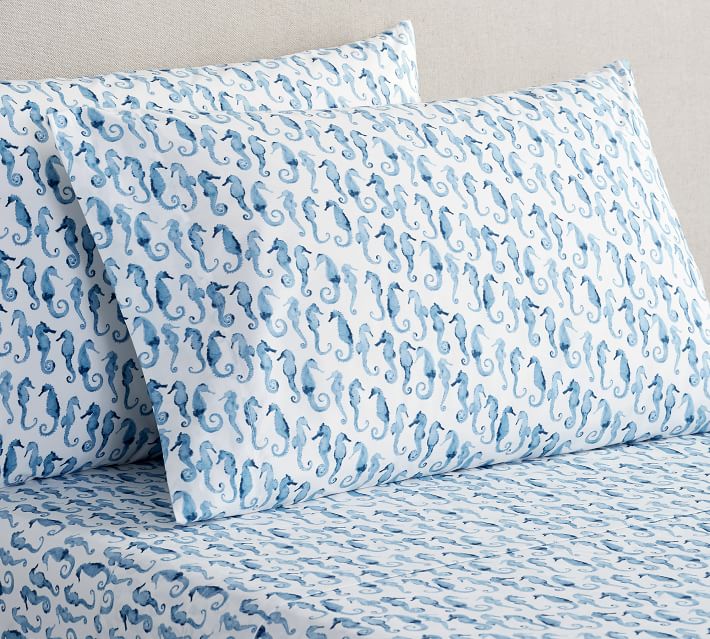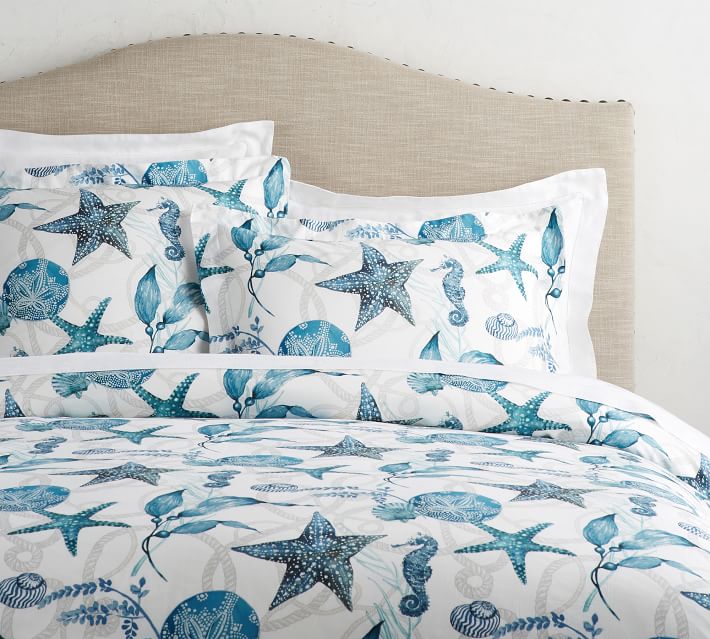
By now, we all know about fertilizer runoff and our marine ecosystems: when it rains, fertilizer from the fields is washed into streams and rivers, where it eventually makes its way to the ocean. The fertilizer causes algae blooms, which releases harmful toxins and deprives all other living things of oxygen; it can shut down entire ecosystems, and cause the death of thousands, if not millions, of coral colonies, and create miles of ecological dead zones. And in addition to the large amounts of chemical fertilizers, nearly 25% of the insecticides and 10% of the pesticides used throughout the world, are applied to conventionally-grown cotton, even though the crop only takes up 3% of the world’s total cultivated area.
There are some simple, straightforward ways we can combat this, such as choosing organic or specially-certified cotton when purchasing new clothes and home furnishings. Pottery Barn is one of the larger retailers to embrace eco-friendly bedding, and their selection of marine-themed products are not only Better Cotton Initiative, OEKO-TEX 100 and/or GOTS certified, but are absolutely charming.

From www.oeko-tex.com: “The STANDARD 100 by OEKO-TEX® is a worldwide consistent, independent testing and certification system for raw, semi-finished, and finished textile products at all processing levels, as well as accessory materials used.
Since its introduction in 1992, the central focus of the STANDARD 100 by OEKO-TEX® has been the development of test criteria, limit values and test methods on a scientific basis. The Standard takes account of:
- Important legal regulations, such as banned Azo colourants, formaldehyde, pentachlorophenol, cadmium, nickel, etc.
- Numerous harmful chemicals, even if they are not yet legally regulated.
- Requirements of Annexes XVII and XIV of the European Chemicals Regulation REACh as well as of the ECHA SVHC Candidate List insofar as they are assessed by expert groups of the OEKO-TEX® Association to be relevant for fabrics, textiles, garments or accessories.
- Requirements from the US Consumer Product Safety Improvement Act (CPSIA) regarding lead.
- Numerous other environmentally relevant substance classes”

From the Better Cotton website: “The Better Cotton Standard System is a holistic approach to sustainable cotton production which covers all three pillars of sustainability: environmental, social and economic. Each of the elements – from the Production Principles and Criteria to the monitoring mechanisms which show Results and Impact – work together to support the Better Cotton Standard System, and the credibility of Better Cotton and BCI. Below is an explanation of each of the component parts which make up the Better Cotton Standard System. Click on the links for more detailed information about each element:
- ‘Production Principles and Criteria’: providing a global definition of Better Cotton through 6 key principles.
- ‘Capacity Building’: supporting and training farmers in growing Better Cotton, through working with experienced partners at field level.
- ‘Assurance Programme’: regular farm assessment and measurement of results through 8 consistent results indicators, encouraging farmers to continuously improve.
- ‘Chain of Custody’: connecting supply and demand in the Better Cotton supply chain.
- ‘Claims Framework’: spreading the word about Better Cotton by communicating powerful data, information and stories from the field.
- ‘Results and Impact’: monitoring and evaluation mechanisms to measure progress/change, to ensure that Better Cotton delivers the intended impact”
You can find the sea pod bedding (organic, Oeko-Tex, and GOTS) HERE
You can find the seahorse bedding (organic and Oeko-Tex) HERE
You can find the coastal bedding (BCI and Oeko-Tex) HERE










0 Comments